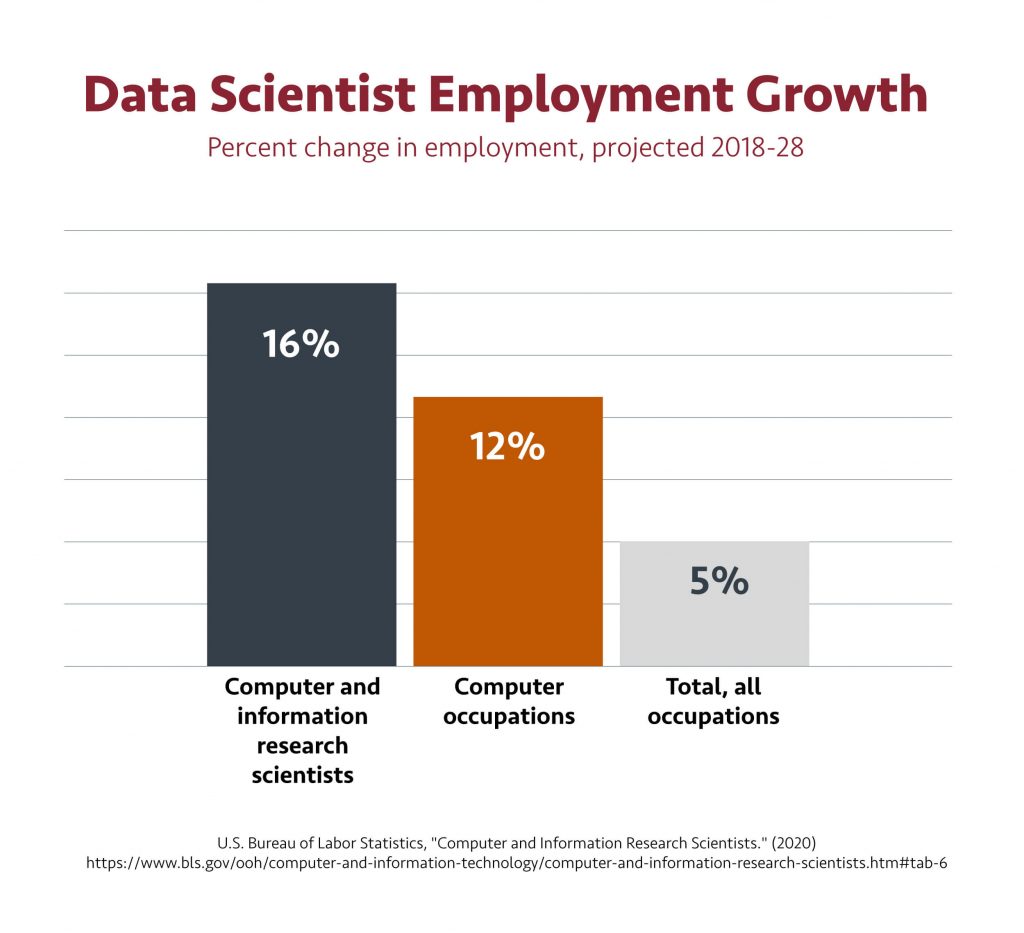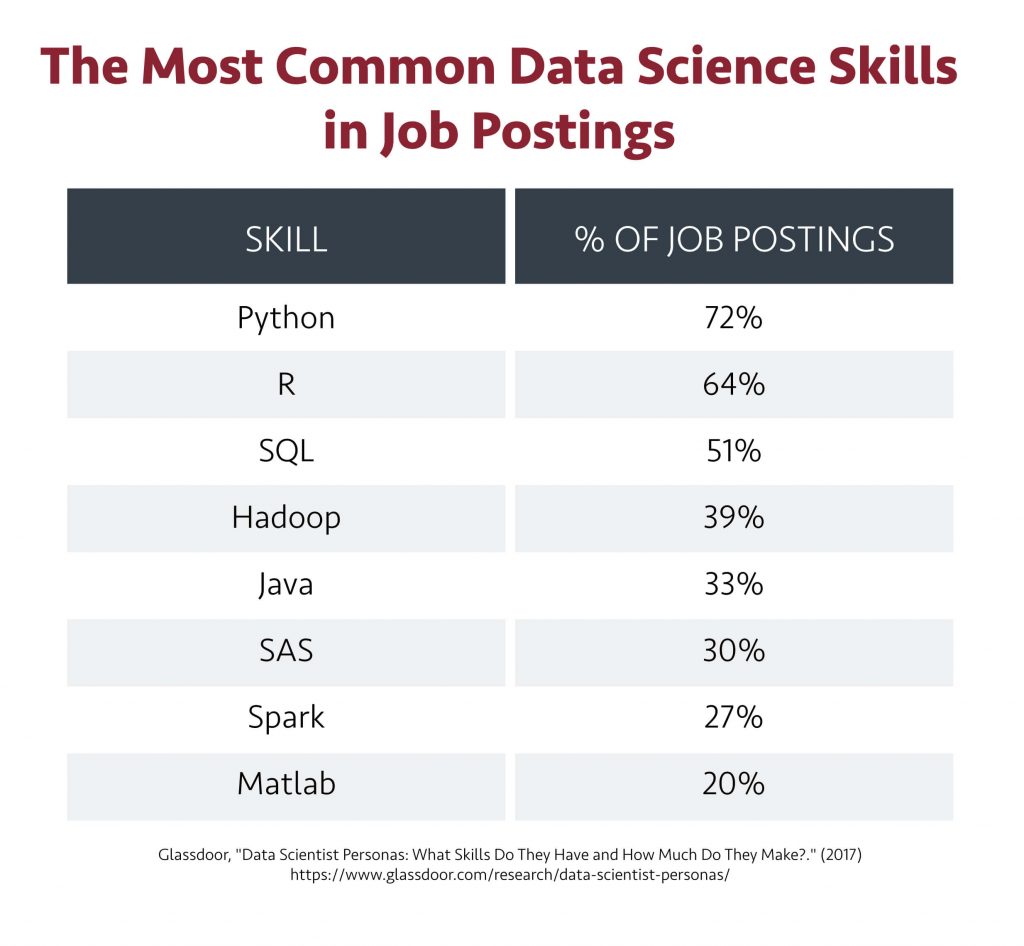How to Become a Data Scientist: Four Essential Steps

If you’re curious about how to become a data scientist, you’re probably the kind of person who loves numbers.
Maybe you like the challenge of solving mathematical problems, or perhaps you enjoy reviewing data and parsing through spreadsheets that your friends dismiss as boring or indecipherable. These puzzles have always been fun for you — but now, you want to put your analytical mind to the test and see if you can build a career out of your inherent skills.
Even if this description doesn’t fit you perfectly, don’t be discouraged! It doesn’t matter if you’re an established, trained mathematician or just a hobbyist with an interest in analysis; with the right resources and enough time and effort, you can become a skilled (and marketable!) data scientist.
In this article, we’ll explain everything you need to know to make your long-awaited career transition.
To become a data scientist, you’ll need to:
- Understand what a data scientist does
- Develop the traits and habits of a good data scientist
- Learn the essential languages and software skills
- Choose your educational pathway
We’ll dive into the specifics of the role, spotlight the qualities that define a successful data scientist, and explain how you can break into the field — even if you don’t have any formal training or prior experience.
Interested? Let’s get started.
1. Understand What a Data Scientist Does
At its most foundational level, the role of a data scientist is deceptively simple.
Data scientists use data to help businesses make better decisions.
The description seems straightforward enough — until you unpack the phrase “use data.” It encompasses a lot. Data scientists are responsible for collecting, managing, and distilling meaning from enormous quantities of data. They build the infrastructure necessary to house it and then deploy their analytical skills to gain a better understanding of markets, consumer bases, and business needs.
As one writer for SAS describes, “They’re part mathematician, part computer scientist and part trend-spotter […] Data scientists are a new breed of analytical data expert who has the technical skills to solve complex problems — and the curiosity to explore what problems need to be solved.”
Data science is a field that demands creativity and encourages curiosity. If one were to distill the spirit of the profession down into a single line, it would have to be: How can we use information to solve issues that we don’t even know we have yet?
The tasks that a data scientist takes on will vary across industries and employers; however, most in the profession share a few core responsibilities. These include but are not limited to:
- Researching and developing statistical models for data analysis
- Working with other department and company leaders to understand business needs
- Developing data-driven strategies to address problems and pursue growth
- Collecting and cleaning large quantities of data
- Looking for patterns and trends in data that can help broaden company knowledge of critical areas (i.e., consumer habits, market needs, etc.) and improve strategic decisions
- Communicating data findings to key decision-makers
These core capabilities, among others, have rendered data scientists all but invaluable in recent years. We live in an era that runs on information and data analysis; today, not using data to inform your strategic decisions isn’t just an oversight — it’s likely to put you out of business.
“Data science is growing up fast,” Harvard Business Review editor Scott Berinato wrote of the matter in 2019. “Over the past five years companies have invested billions to get the most-talented data scientists to set up shop, amass zettabytes of material, and run it through their deduction machines to find signals in the unfathomable volume of noise.”
The rise of Big Data has changed the game in just about every industry, from retail to healthcare and professional sports. Data scientists’ abilities to squeeze insights out of information have cemented them as in-demand and highly marketable professionals.
Currently, the Bureau of Labor Statistics estimates that positions for data scientists will increase by a whopping 16 percent between 2018 and 2028 — a rate more than three times that of the average growth expected for all other occupations.

It’s a high-potential profession, to be sure. But how do you become a data scientist, exactly? First, you need to develop an understanding of the habits and skills necessary for the field.
2. Develop The Traits and Habits of a Good Data Scientist
If you’re wondering how to become a data scientist, you’ll need to become familiar with the helpful habits and traits that will allow you to succeed in the role. You can’t just pick up a few technical skills and call it a day; developing your mind and personal character outside of academic studies is just as crucial to your professional success as learning a database or programming language.
To borrow a quote from tech journalist Bob Violino, “Extracting true business value from data requires a unique combination of technical skills, mathematical know-how, storytelling, and intuition.”
In theory, the number of soft skills that can help you get into data science is infinite — but there are a few that are essential for those looking to break into the field. Students and new professionals aren’t always expected to have all of these abilities mastered within their first few days on the job, but they do need to be ready to learn and adapt quickly as they grow into their role.
Curiosity
Curiosity and an insatiable desire to learn are among the most crucial character traits shared by successful data scientists. Even the most well-educated and seasoned professionals need to stay on top of developments in ever-changing fields such as machine learning, programming, and database management — or they’ll soon find themselves outdated and ill-prepared.
Prioritization
Due to the complex and technical nature of their work, data scientists often have to shape their own to-do lists and make difficult project decisions without upper-level direction or input. The ability to think critically, proceed prudently, and shift priorities as needed are critical for independent data scientists. These professionals also need to adopt an impact-oriented mentality that helps them focus their efforts on the areas or tasks that will provide the most overall benefit to their employer.
Improving your ability to prioritize requires at least a decent understanding of your employer’s structure, goals, and essential processes. You also need to practice adopting a mindful and self-aware attitude that encourages you to reflexively examine your own activities with an eye toward constant improvement.
Communication
A computer screen may not care if you lack conversational skills or social inclination, but these personality quirks can become a significant source of workplace friction with coworkers. Data scientists often need to collaborate with colleagues in other professional departments, clients, and executives, many of whom lack the specialized training to understand complex data concepts.
Aspiring data scientists need to know how to communicate effectively with everyone — from their tech-savvy colleagues to business-focused bosses.
The best way to build social skills is to use them, especially if the thought of socializing makes you uncomfortable. There’s nothing strange about being afraid to speak in public or lead a group discussion; however, these anxieties can hold you back in the long run if you don’t actively address them early in your career.
Put yourself out there! Look at every conversational exchange as an opportunity to develop your communication skills and better yourself as a professional.
Additional Resources:
- 20 Tips for Mastering the Art of Public Speaking (Inc.)
- How to Explain Technical Ideas to a Non-Technical Audience (Lucid Chart)
- Data Science and the Art of Persuasion (Harvard Business Review)
Methodology
Understanding the significance and value of methodology is an essential trait for anyone practicing information science. Strict attention to detail and adherence to established methods are crucial skills in both programming and mathematics.
Data scientists should, at all times, be mindful of the way that they structure and approach problems so they can create consistency across projects and avoid confusion.
3. Learn Essential Languages and Software Skills
As important as soft skills are, anyone wondering how to get into data science will need to become familiar with the tools of the trade — the technical skills that you’ll need to succeed in the field.
While it’s impossible to create an exhaustive list of necessary skills for the profession, given that every company has its own approach, goals, and methods, there are a few fundamental competencies that every data scientist must have.
Job posting data from a 2017 Glassdoor report indicates that employers have a strong preference for Python (72 percent), followed by R (64 percent), SQL (51 percent), Hadoop (39 percent), and Java (33 percent). Below, we cover a few of these skills — and a few dark-horse talents that you might not realize are critical to success.

Python
Despite its association with entry-level web development, Python is incredibly useful to data scientists for managing and analyzing information. It’s best known for its approachable simplicity as well as its support for rapid development. Python also offers value in the form of easy debugging and its relatively low maintenance requirements.
While you must learn all the basics of the language, it’s also a good idea to focus your advanced training on applications related to data management, rather than programming or software development. These skill sets share a similar base but eventually diverge to concentrate on different tasks and abilities.
Hadoop
Apache Hadoop is an open-source collection of utilities that has several applications in computation and data interpretation. Hadoop is capable of processing an enormous amount of information at once, which makes it invaluable as a data science tool.
Hadoop is compartmentalized into several primary modules, including Hadoop Distributed File System (HDFS), Yet Another Resource Negotiator (YARN), MapReduce, and Hadoop Common. Each of these modules provides essential features and functionality that expand the utility of the others; taken together, they offer tremendous and multifaceted support to data scientists.
Tableau
As a data-oriented analytics platform designed for commercial use, Tableau has a lot to offer in terms of visualizing data and communicating results. This platform provides a digital environment that helps users store, manage, and organize information through a dashboard and user-friendly interface. Its integrated mapping and geocoding features are particularly useful for industries and applications that have strong geographic ties.
Excel
Microsoft Excel has long been a bread-and-butter utility for all kinds of technical professionals, from developers to accountants. Given this, it’s no surprise that the software is also a staple in the field of data science.
This spreadsheet software offers a well-developed framework for the aggregation, collation, and management of data sets. Its versatility and compatibility with other popular programs make it an indispensable asset in any data scientist’s arsenal.
Fundamental Statistics
Data scientists aren’t statisticians, but they do need to understand many of the core concepts and methods of the field to form a foundation for their own practices. Statistical learning is particularly relevant as a component of machine learning — a discipline that is currently driving the future of the data science profession.
Understanding statistical analysis and development helps you better understand every step of the analytical process, from acquiring data to reviewing your final conclusions. Mastering the fundamentals of this field of study improves your ability to classify information, apply advanced sampling techniques, and produce meaningful visualizations to help others understand the impact and significance of the data.
Additional Resources:
- Statistics and Probability (Khan Academy)
- The 10 Statistical Techniques Data Scientists Need to Master (KD Nuggets)
- How to Dominate the Statistics Portion of Your Data Science Interview (Oracle)
4. Choose Your Educational Pathway
Let’s get one point straight right now: there is no “correct” way to become a data scientist.
Today, we’re lucky enough to have an abundance of academic options available, from conventional college courses to boot camps to self-guided tutorials. Every learner’s educational journey will be a little different, and the path that works for one person may not suit another. The educational route you choose will be the one that works best for your needs, learning preferences, and unique situation.
So, before we start profiling your options, let’s walk through a quick questionnaire to determine your specific needs and priorities. Ask yourself:
- How much time and money do I have to dedicate to my education?
- What’s my expected timeline for upskilling and landing a job in the data science field?
- Can I balance a full-time schedule with my current work and personal obligations, or do I need a part-time program?
- How much instructor support or guidance do I need as a learner?
- Would I learn better in an in-person or virtual environment?
Answering these questions will help you narrow in on benchmarks for program price, duration, schedule, and type. Keep them in mind as you assess the learning paths below.
College
Four-year undergraduate degrees are arguably the most conventional means of gaining the proficiencies necessary for a career in data science. Those who enroll in college courses commit to a full-time and often in-person schedule and gain a comprehensive understanding of both theoretical principles and practical skills.
Today, skyrocketing student interest in data science has prompted some colleges and universities to create majors specifically for data science. However, if your chosen school doesn’t offer such a specific track, you can cobble together a suitable degree from related subjects. As one writer for Dummies puts it, “It’s okay if your degree doesn’t say ‘analytics’ if you have a course load that meets the needs of potential employers.”
Popular majors for aspiring data scientists include math, statistics, and computer science. Other, less-related majors like business can also provide a useful foundation, though learners may have to take additional courses to brush up on necessary technical skills.
A four-year college degree has its benefits and challenges. On the one hand, formal undergraduate programs are comprehensive and well-regarded by employers; on the other, they tend to be more expensive and take more time than other educational pathways.
Tutorials and Self-Directed Learning
The web-based nature of programming and computer science makes it extremely conducive to online or remote learning. It’s certainly possible to take command of your own education through digital resources, tutorials, and learning programs if you have the discipline and desire to push yourself through. Some of these resources and services are even available free of charge for those who have limited financial flexibility or simply want to explore the field before making a commitment.
Self-directed learning offers extreme flexibility and can be a very budget-friendly option, but it also means taking charge of your education. Without instructor guidance, it’s easy to get lost, stuck, or confused.
The best way to get started is to focus on learning programming basics, like Python and R, before moving on to statistics and mathematics. It’s also a good idea to try to connect with people currently working in the profession and ask them for tips, tricks, and ideas on how to get into data science in a self-guided capacity.
Need help finding your first tutorials? These resources can give you a boost.
Digital Learning Platforms:
- Freecodecamp — Offers a host of free programs on data science, programming, and more. This platform also supports a thriving community of tech-minded professionals.
- Udemy — Provides access to paid and free courses. Note that this platform is known for its frequent sales; if you want to save money, keep an eye out for discounted opportunities!
- Khan Academy — Offers a comprehensive dive into statistical concepts and foundational data science, among other subjects.
Books:
- Numsense! Data Science for the Layman: No Math Added — Annalyn Ng and Kenneth Soo. A beginner-friendly, readable dive into algorithms and their uses.
- Doing Data Science: Straight Talk from the Frontline — Cathy O’Neil and Rachel Schutt. A clear, easy-to-follow course that guides readers through the foundational concepts of data science.
- Think Stats — Allen B. Downey. A digestible overview of statistics and probability fundamentals.
Boot Camps
Much like the brief and intense training period that new military members go through, programming and data science boot camps are optimized to provide as much practical education as possible in a short time. This kind of training is typically more affordable and faster, generally 3 to 4 months, compared to a traditional degree program. These boot camps may take place either physically — on campus, for example — or virtually.
According to HackerRank, roughly one in six Gen Z tech professionals has turned to boot camps to acquire needed technical skills. While young people are at the forefront of this kind of learning, boot camps are appropriate for learners of all ages.
Interested in seeing what a boot camp curriculum has to offer? Check out The Data Analysis and Visualization Boot Camp at Texas McCombs.
Now What?
After reading this article, you should have a clear idea of how to become a data scientist and achieve the career you’ve always wanted. We’ve outlined the possible paths; now, it’s up to you to choose one and walk it.
So, where will you go? Will you choose to explore a college program, opt for a boot camp, or dive into data science through more independent means? The choice is up to you!

 Live Chat
Live Chat